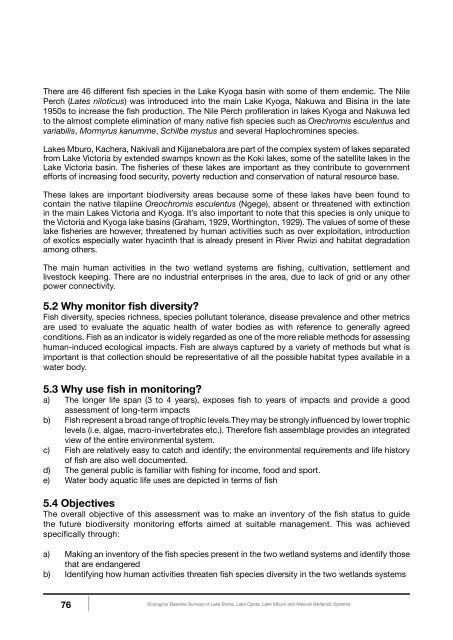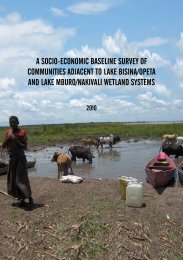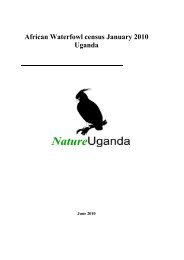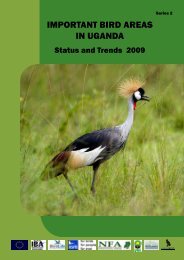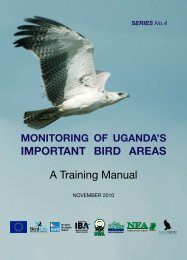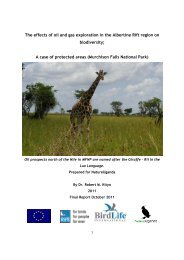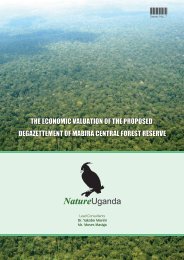A Ecological Baseline Surveys Of: - Lake Bisina - Nature Uganda
A Ecological Baseline Surveys Of: - Lake Bisina - Nature Uganda
A Ecological Baseline Surveys Of: - Lake Bisina - Nature Uganda
Create successful ePaper yourself
Turn your PDF publications into a flip-book with our unique Google optimized e-Paper software.
There are 46 different fish species in the <strong>Lake</strong> Kyoga basin with some of them endemic. The Nile<br />
Perch (Lates niloticus) was introduced into the main <strong>Lake</strong> Kyoga, Nakuwa and <strong>Bisina</strong> in the late<br />
1950s to increase the fish production. The Nile Perch profileration in lakes Kyoga and Nakuwa led<br />
to the almost complete elimination of many native fish species such as Orechromis esculentus and<br />
variabilis, Mormyrus kanumme, Schilbe mystus and several Haplochromines species.<br />
<strong>Lake</strong>s Mburo, Kachera, Nakivali and Kijjanebalora are part of the complex system of lakes separated<br />
from <strong>Lake</strong> Victoria by extended swamps known as the Koki lakes, some of the satellite lakes in the<br />
<strong>Lake</strong> Victoria basin. The fisheries of these lakes are important as they contribute to government<br />
efforts of increasing food security, poverty reduction and conservation of natural resource base.<br />
These lakes are important biodiversity areas because some of these lakes have been found to<br />
contain the native tilapiine Oreochromis esculentus (Ngege), absent or threatened with extinction<br />
in the main <strong>Lake</strong>s Victoria and Kyoga. It’s also important to note that this species is only unique to<br />
the Victoria and Kyoga lake basins (Graham, 1929, Worthington, 1929). The values of some of these<br />
lake fisheries are however, threatened by human activities such as over exploitation, introduction<br />
of exotics especially water hyacinth that is already present in River Rwizi and habitat degradation<br />
among others.<br />
The main human activities in the two wetland systems are fishing, cultivation, settlement and<br />
livestock keeping. There are no industrial enterprises in the area, due to lack of grid or any other<br />
power connectivity.<br />
5.2 Why monitor fish diversity?<br />
Fish diversity, species richness, species pollutant tolerance, disease prevalence and other metrics<br />
are used to evaluate the aquatic health of water bodies as with reference to generally agreed<br />
conditions. Fish as an indicator is widely regarded as one of the more reliable methods for assessing<br />
human-induced ecological impacts. Fish are always captured by a variety of methods but what is<br />
important is that collection should be representative of all the possible habitat types available in a<br />
water body.<br />
5.3 Why use fish in monitoring?<br />
a) The longer life span (3 to 4 years), exposes fish to years of impacts and provide a good<br />
assessment of long-term impacts<br />
b) Fish represent a broad range of trophic levels.They may be strongly influenced by lower trophic<br />
levels (i.e. algae, macro-invertebrates etc.). Therefore fish assemblage provides an integrated<br />
view of the entire environmental system.<br />
c) Fish are relatively easy to catch and identify; the environmental requirements and life history<br />
of fish are also well documented.<br />
d) The general public is familiar with fishing for income, food and sport.<br />
e) Water body aquatic life uses are depicted in terms of fish<br />
5.4 Objectives<br />
The overall objective of this assessment was to make an inventory of the fish status to guide<br />
the future biodiversity monitoring efforts aimed at suitable management. This was achieved<br />
specifically through:<br />
a) Making an inventory of the fish species present in the two wetland systems and identify those<br />
that are endangered<br />
b) Identifying how human activities threaten fish species diversity in the two wetlands systems<br />
76<br />
<strong>Ecological</strong> <strong>Baseline</strong> <strong>Surveys</strong> of <strong>Lake</strong> <strong>Bisina</strong>, <strong>Lake</strong> Opeta, <strong>Lake</strong> Mburo and Nakivali Wetlands Systems


